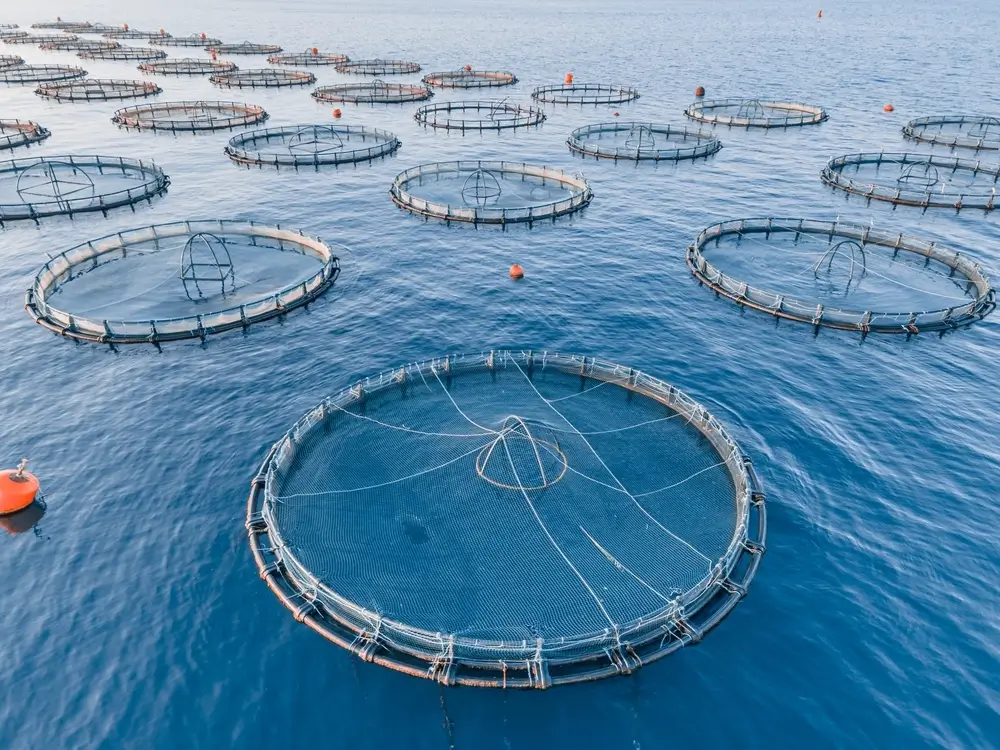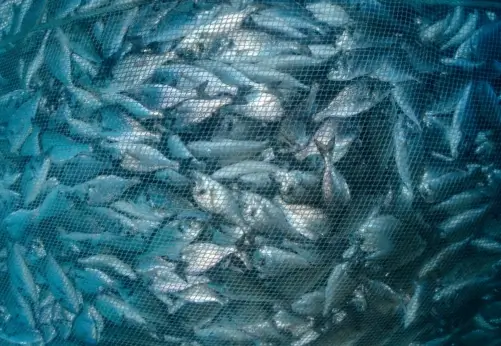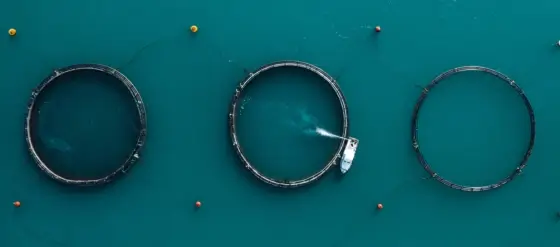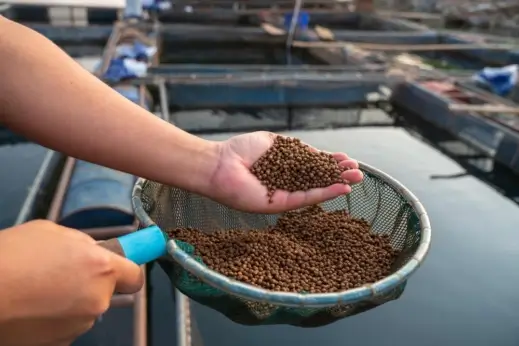The World is Farming More Seafood Than it Catches. Is That a Good Thing?
Both aquaculture and fisheries have environmental and climate impacts — and they overlap more than you'd think.
The World is Farming More Seafood Than it Catches. Is That a Good Thing?
Both aquaculture and fisheries have environmental and climate impacts — and they overlap more than you'd think.

An aerial view of a fish farm. via Shutterstock/Leonid Sorokin
A new report from the United Nations’ Food and Agriculture Organization, or FAO, has found that more fish were farmed worldwide in 2022 than harvested from the wild, an apparent first.
Last week, the FAO released its annual report on the state of aquaculture — which refers to the farming of both seafood and aquatic plants — and fisheries around the world. The organization found that global production from both aquaculture and fisheries reached a new high — 223.3 million metric tons of animals and plants — in 2022. Of that, 185.4 million metric tons were aquatic animals, and 37.8 million metric tons were algae. Aquaculture was responsible for 51 percent of aquatic animal production in 2022, or 94.4 metric tons.
The milestone was in many ways an expected one, given the world’s insatiable appetite for seafood. Since 1961, consumption of seafood has grown at twice the annual rate of the global population, according to the FAO. Because production levels from fisheries are not expected to change significantly in the future, meeting the growing global demand for seafood almost certainly necessitates an increase in aquaculture.

Though fishery production levels fluctuate from year to year, “it’s not like there’s new fisheries out there waiting to be discovered,” said Dave Martin, program director for Sustainable Fisheries Partnerships, an international organization that works to reduce the environmental impact of seafood supply chains. “So any growth in consumption of seafood is going to come from aquaculture.”
But the rise of aquaculture underscores the need to transform seafood systems to minimize their impact on the planet. Both aquaculture and fisheries — sometimes referred to as capture fisheries, as they involve the capture of wild seafood — come with significant environmental and climate considerations. What’s more, the two systems often depend on each other, making it difficult to isolate their climate impacts.
“There’s a lot of overlap between fisheries and aquaculture that the average consumer may not see,” said Dave Love, a research professor at the Center for a Livable Future at Johns Hopkins University.

Studies have shown that the best diet for the planet is one free of animal protein. Still, seafood generally has much lower greenhouse gas emissions than other forms of protein from land-based animals. And given many people’s unwillingness or inability to go vegan, the FAO recommends transforming, adapting, and expanding sustainable seafood production to feed the world’s growing population and improve food security.
But “there’s a lot of ways to do aquaculture well, and there’s a lot of ways to do it poorly,” said Martin. Aquaculture can result in nitrogen and phosphorus being released into the natural environment, damaging aquatic ecosystems. Farmed fish can also spread disease to wild populations, or escape from their confines and breed with other species, resulting in genetic pollution that can disrupt the fitness of a wild population. Martin points to the diesel fuel used to power equipment on certain fish farms as a major source of aquaculture’s environmental impact. According to an analysis from the climate solutions nonprofit Project Drawdown, swapping out fossil fuel-based generators on fish farms for renewable-powered hybrids would prevent 500 million to 780 million metric tons of carbon emissions by 2050.

Other areas for improvement will vary depending on the specific species being farmed. In 2012, a U.N. study found that mangrove forests — a major carbon sink — have suffered greatly due to the development of shrimp and fish farming. Today, industry stakeholders have been exploring how new approaches and techniques from shrimp farmers can help restore mangroves.
Meanwhile, wild fishing operations present their own environmental problems. For example, poorly managed fisheries can harvest fish more quickly than wild populations can breed, a phenomenon known as overfishing. Certain destructive wild fishing techniques also kill a lot of non-targeted species, known as bycatch, threatening marine biodiversity.
But the line between aquaculture and fish harvested from the wild isn’t as clear as it may seem. For example, pink salmon that are raised in hatcheries and then released into the wild to feed, mature, and ultimately be caught again are often marketed as “wild caught.” Lobsters, caught wild in Maine, are often fed bait by fisherman to help them put on weight. “It’s a wild fishery,” said Love — but the lobster fishermen’s practice of fattening up their catch shows how human intervention is present even in wild-caught operations.

On the flipside, in a majority of aquaculture systems, farmers provide their fish with feed. That feed sometimes includes fish meal, says Love, a powder that comes from two sources: seafood processing waste (think: fish guts and tails) and wild-caught fish.
All of this can result in a confusing landscape for climate- or environmentally-conscientious consumers who eat fish. But Love recommends a few ways in which consumers can navigate choice when shopping for seafood. Buying fresh fish locally helps shorten supply chains, which can lower the carbon impact of eating aquatic animals. “In our work, we’ve found that the big impact from transport is shipping fresh seafood internationally by air,” he said. Most farmed salmon, for example, sold in the U.S. is flown in.
From both a climate and a nutritional standpoint, smaller fish and sea vegetables are also both good options. “Mussels, clams, oysters, seaweed — they’re all loaded with macronutrients and minerals in different ways” compared to fin fish, said Love.
This story was originally published by Grist. Sign up for Grist’s weekly newsletter here.
Grist is a nonprofit, independent media organization dedicated to telling stories of climate solutions and a just future. Learn more at Grist.org
Follow us
This work is licensed under a Creative Commons Attribution-NoDerivatives 4.0 International License.
Want to republish a Modern Farmer story?
We are happy for Modern Farmer stories to be shared, and encourage you to republish our articles for your audience. When doing so, we ask that you follow these guidelines:
Please credit us and our writers
For the author byline, please use “Author Name, Modern Farmer.” At the top of our stories, if on the web, please include this text and link: “This story was originally published by Modern Farmer.”
Please make sure to include a link back to either our home page or the article URL.
At the bottom of the story, please include the following text:
“Modern Farmer is a nonprofit initiative dedicated to raising awareness and catalyzing action at the intersection of food, agriculture, and society. Read more at <link>Modern Farmer</link>.”
Use our widget
We’d like to be able to track our stories, so we ask that if you republish our content, you do so using our widget (located on the left hand side of the article). The HTML code has a built-in tracker that tells us the data and domain where the story was published, as well as view counts.
Check the image requirements
It’s your responsibility to confirm you're licensed to republish images in our articles. Some images, such as those from commercial providers, don't allow their images to be republished without permission or payment. Copyright terms are generally listed in the image caption and attribution. You are welcome to omit our images or substitute with your own. Charts and interactive graphics follow the same rules.
Don’t change too much. Or, ask us first.
Articles must be republished in their entirety. It’s okay to change references to time (“today” to “yesterday”) or location (“Iowa City, IA” to “here”). But please keep everything else the same.
If you feel strongly that a more material edit needs to be made, get in touch with us at [email protected]. We’re happy to discuss it with the original author, but we must have prior approval for changes before publication.
Special cases
Extracts. You may run the first few lines or paragraphs of the article and then say: “Read the full article at Modern Farmer” with a link back to the original article.
Quotes. You may quote authors provided you include a link back to the article URL.
Translations. These require writer approval. To inquire about translation of a Modern Farmer article, contact us at [email protected]
Signed consent / copyright release forms. These are not required, provided you are following these guidelines.
Print. Articles can be republished in print under these same rules, with the exception that you do not need to include the links.
Tag us
When sharing the story on social media, please tag us using the following: - Twitter (@ModFarm) - Facebook (@ModernFarmerMedia) - Instagram (@modfarm)
Use our content respectfully
Modern Farmer is a nonprofit and as such we share our content for free and in good faith in order to reach new audiences. Respectfully,
No selling ads against our stories. It’s okay to put our stories on pages with ads.
Don’t republish our material wholesale, or automatically; you need to select stories to be republished individually.
You have no rights to sell, license, syndicate, or otherwise represent yourself as the authorized owner of our material to any third parties. This means that you cannot actively publish or submit our work for syndication to third party platforms or apps like Apple News or Google News. We understand that publishers cannot fully control when certain third parties automatically summarize or crawl content from publishers’ own sites.
Keep in touch
We want to hear from you if you love Modern Farmer content, have a collaboration idea, or anything else to share. As a nonprofit outlet, we work in service of our community and are always open to comments, feedback, and ideas. Contact us at [email protected].by Frida Garza, Grist, Modern Farmer
June 21, 2024
Modern Farmer Weekly
Solutions Hub
Innovations, ideas and inspiration. Actionable solutions for a resilient food system.
ExploreExplore other topics
Share With Us
We want to hear from Modern Farmer readers who have thoughtful commentary, actionable solutions, or helpful ideas to share.
SubmitNecessary cookies are absolutely essential for the website to function properly. This category only includes cookies that ensures basic functionalities and security features of the website. These cookies do not store any personal information.
Any cookies that may not be particularly necessary for the website to function and are used specifically to collect user personal data via analytics, ads, other embedded contents are termed as non-necessary cookies.
Thank you so much for sharing. Keep it up and update more information.